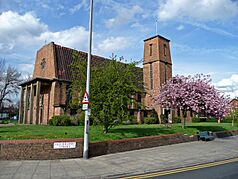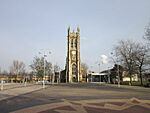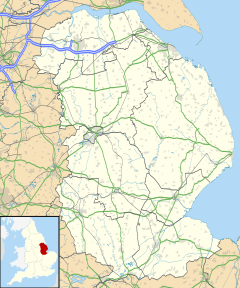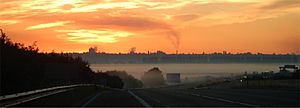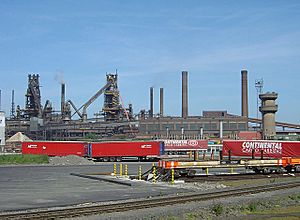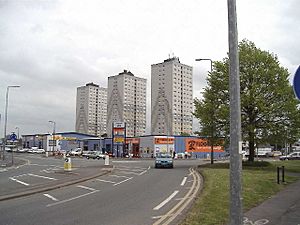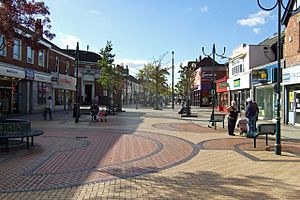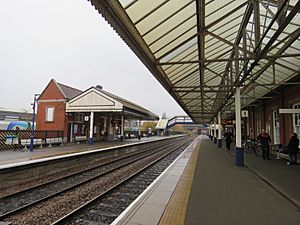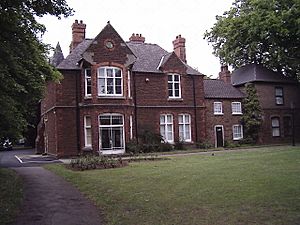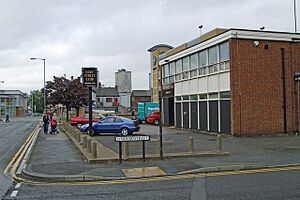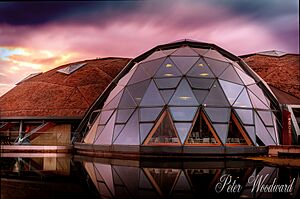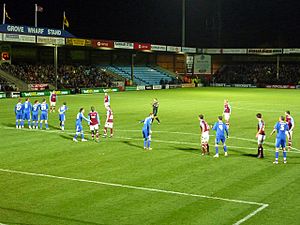Scunthorpe facts for kids
Quick facts for kids Scunthorpe |
|
|---|---|
| Town | |
|
Clockwise from top: St Hugh's Church, Scunthorpe Mill, High Street, Church Square and The Central Park Fountain |
|
| Population | 81,576 (2021 Census) |
| OS grid reference | SE893102 |
| • London | 145 mi (233 km) S |
| Unitary authority | |
| Ceremonial county | |
| Region | |
| Country | England |
| Sovereign state | United Kingdom |
| Post town | SCUNTHORPE |
| Postcode district | DN15 – 17 |
| Dialling code | 01724 |
| Police | Humberside |
| Fire | Humberside |
| Ambulance | East Midlands |
| EU Parliament | Yorkshire and the Humber |
| UK Parliament |
|
Scunthorpe (/ˈskʌnθɔːrp/) is a town in North Lincolnshire, England. It is known for its industries, especially steelmaking. Scunthorpe is the third largest town in Lincolnshire. It is smaller only than Lincoln and Grimsby. In 2021, about 81,286 people lived there.
Contents
History of Scunthorpe
Scunthorpe became a town because of the iron found in the ground nearby. Iron works started in the 1850s. The number of people living here grew a lot. It went from 1,245 in 1851 to 45,840 in 1941. As the town grew, it joined with nearby villages. These included Frodingham, Crosby, Brumby, and Ashby.
Scunthorpe became an 'urban district' in 1891. This means it had its own local government. In 1919, it joined with Brumby and Frodingham. Then, in 1936, it became a 'municipal borough', which is a bigger type of town government.
What Does Scunthorpe Mean?
The town's name, Escumesthorpe, is found in the old Domesday Book from 1086. This name comes from Old Norse, which is an old language from Scandinavia. It means "Skuma's homestead." A homestead is like a farm or home area. People think this place was near where the Market Hill is today.
Geography and Landscape
Scunthorpe is on a ridge of land that slopes down towards the River Trent. The area around it has mostly low hills and flat plains. Even though the town has a lot of factories, it is surrounded by rich farmland and forests.
The town is about one mile east of the River Trent. It is also about 8 miles south of the Humber Estuary. The Lincolnshire Wolds are 15 miles to the east. Lincoln is about 25 miles south. Scunthorpe is at the end of the M181 road. It is 42 miles from Sheffield.
Nearby cities and towns include Hull (18 miles northeast), Doncaster (20 miles west), Grimsby (22 miles east), and York (46 miles northwest).
Climate in Scunthorpe
Like most of the United Kingdom, Scunthorpe has an oceanic climate. This means it has mild winters and cool summers. It also gets rain throughout the year.
| Climate data for Scunthorpe | |||||||||||||
|---|---|---|---|---|---|---|---|---|---|---|---|---|---|
| Month | Jan | Feb | Mar | Apr | May | Jun | Jul | Aug | Sep | Oct | Nov | Dec | Year |
| Mean daily maximum °C (°F) | 5.8 (42.4) |
6.1 (43.0) |
8.9 (48.0) |
11.4 (52.5) |
15.2 (59.4) |
18.4 (65.1) |
20.3 (68.5) |
20.1 (68.2) |
17.7 (63.9) |
13.8 (56.8) |
8.9 (48.0) |
6.5 (43.7) |
12.8 (55.0) |
| Mean daily minimum °C (°F) | 0.6 (33.1) |
0.5 (32.9) |
1.9 (35.4) |
3.6 (38.5) |
6.5 (43.7) |
9.5 (49.1) |
11.4 (52.5) |
11.4 (52.5) |
9.5 (49.1) |
6.8 (44.2) |
3.2 (37.8) |
1.4 (34.5) |
5.5 (41.9) |
| Average precipitation mm (inches) | 48 (1.9) |
38 (1.5) |
48 (1.9) |
48 (1.9) |
51 (2.0) |
53 (2.1) |
53 (2.1) |
64 (2.5) |
48 (1.9) |
48 (1.9) |
56 (2.2) |
53 (2.1) |
610 (24.0) |
Economy and Industries
Steel Industry in Scunthorpe
The iron industry in Scunthorpe began in the mid-1800s. This happened after iron ore was found in the ground east of the town. At first, the iron ore was sent to other places to be made into iron. But after a railway was built in the 1860s, Scunthorpe started making its own iron. It used local iron ore and coal brought in by train. This led to the town growing very quickly.
Over time, the steel companies in Scunthorpe joined together. By 1967, all three main works became part of British Steel Corporation. From the 1970s, they started using iron ore brought in from other countries. This ore had more iron in it. The way steel was made also changed to a newer, faster method. Two of the older works closed in the early 1980s.
Later, British Steel became part of Corus, then Tata Steel Europe. In 2016, the Scunthorpe steelworks was sold to Greybull Capital. In May 2019, the company, British Steel Limited, went out of business for a while.
Other businesses linked to the steelworks include metal engineering and a company called BOC that makes industrial gases.
Other Businesses in Scunthorpe
Even though steel is very important, Scunthorpe has other types of businesses too. These include making food, moving goods around, and shops. North of the town, there's a company called Bell Waste Control that helps manage waste from businesses.
On the Foxhills Industrial Park, there are many distribution companies. One big one is Nisa, a co-operative that has its main UK office there. Wren Kitchens also has a large factory on this park, where many people work.
Other companies include 2 Sisters Food Group, which processes chicken. Key Country Foods makes meat products. The Sauce Company makes sauces and soups for restaurants and supermarkets. There are also many smaller companies that make things or do light engineering.
Shopping in Scunthorpe
Scunthorpe has two main shopping areas: the Foundry Shopping Centre and the Parishes Centre. The Foundry was built in the 1960s/70s. The Parishes Centre was built in the early 2000s where the old bus station used to be. You can also find many well-known shops on High Street.
There are also large supermarkets in the area. These include Tesco Extra, Aldi, Sainsbury's, Morrisons, and Asda. In 2014, Marks and Spencer opened a new store at the North Lincolnshire Shopping Park. This shopping park also has other popular stores like Boots and Costa Coffee.
The town's market, which used to be mostly indoors, has moved to a new place called St John's Market. It opened in March 2019.
Transport in Scunthorpe
Scunthorpe has a railway station with two platforms. Trains run from Liverpool Lime Street to Cleethorpes. Two train companies, TransPennine Express and Northern Trains, use this station.
The M180 road is about 5 miles south of Scunthorpe. It connects to the town using the M181 and A1077M roads. Before the M180 opened in 1979, all traffic went on the A18 over Keadby Bridge. Humberside Airport is a short drive east along the M180.
The town's bus station is on Fenton Street. Most buses are run by Stagecoach in Lincolnshire. They operate services within the town and to other places. East Yorkshire also runs buses to Hull and Goole.
People and Population
In 2021, the population of Scunthorpe was 81,286 people. The wider urban area, which includes nearby Messingham, had about 84,665 people.
The 2021 Census showed that most people in Scunthorpe (90.4%) were White British. Other groups included British Asian (6%), Mixed-race British (1.4%), and Black British (0.8%). About 51% of the people were Christian. About 42.1% said they had no religion, and 5% were Muslim.
Scunthorpe has the largest British Asian community in Lincolnshire. The towns of Lincoln and Grimsby also have large Asian communities.
Culture and Arts
The North Lincolnshire Museum is on Oswald Road, close to the railway station. The old St John the Evangelist church is now the 20–21 Visual Arts Centre, which shows art. The Plowright Theatre, named after actress Joan Plowright, is on Laneham Street. It was built in 1958 as the Scunthorpe Civic Theatre. The Baths Hall, which reopened in 2011, is a large venue that hosts music and theatre shows.
The Scunthorpe Co-operative Junior Choir won the BBC Radio 3 Choir of the Year award in 2008. The main choir has 90 members aged 9 to 19. They also have two training choirs for children as young as 3. They have made CDs and performed many concerts. They are known internationally and have traveled the world.
In 2012, Scunthorpe was the setting for an opera called Cycle Song. It was about a former steelworker and Olympic cyclist named Lal White. The Scunthorpe Co-operative Junior Choir and over a thousand local people took part in the show.
Media and Entertainment
Television and Radio
- BBC Look North covers the area from Hull.
- Calendar is broadcast by ITV Yorkshire from Leeds.
- BBC Radio Humberside broadcasts on 95.9 FM from Hull. It covers the old county of Humberside.
- Greatest Hits Radio Lincolnshire broadcasts on 102.2 FM from Lincoln. It covers all of Lincolnshire.
- Hits Radio East Yorkshire & North Lincolnshire broadcasts on 96.9 FM from Hull. It also covers North Lincolnshire, including Scunthorpe.
Newspapers
The local newspaper is the Scunthorpe Telegraph. You can also read it online.
Entertainment Venues
Scunthorpe has a leisure centre called The Pods. It is next to Pittwood House. There is also a museum, art galleries, and craft centres. The town has several clubs, pubs, and bars. There is a Vue cinema near the bus station.
The Baths Hall on Doncaster Road was a popular music venue. It closed for a while for big repairs. The building reopened in November 2011.
Education in Scunthorpe
Primary Schools
Some primary schools in Scunthorpe are: Frodingham Infant School, Scunthorpe CofE Primary School, Oasis Academy Henderson Avenue, Crosby Primary School, and Holme Valley Primary School.
Secondary Schools
Secondary schools include: The St Lawrence Academy, Engineering UTC Northern Lincolnshire, Outwood Academy Brumby, Melior Community Academy, and Frederick Gough School.
Further Education
John Leggott Sixth-Form College (JLC) is on West Common Lane. North Lindsey College is nearby on Kingsway.
Scunthorpe also has UCNL, which is a university centre. It offers courses for about 1,500 students.
Sports in Scunthorpe
Football
The town has a football club called Scunthorpe United. Their nickname is "The Iron." They play at Glanford Park. For most of their history, they have played in the lower leagues of English football. In 2007, they won promotion to the Football League Championship, which is a higher league. They were relegated in 2008 but came back up in 2009. In 2022, Scunthorpe was relegated from the Football League for the first time. In 2023, they were relegated again to the National League North.
Famous football players Kevin Keegan and Ray Clemence both played for Scunthorpe United in the early 1970s. They later became very famous playing for Liverpool. Former England cricket captain Ian Botham also played some games for the club. The team's mascot is called the "Scunny Bunny."
Other local football teams include Appleby Frodingham and Bottesford Town.
Rugby
Scunthorpe Rugby Club plays in the National League 2 North. This is the fourth level of English rugby union. Their home ground is Heslam Park. Scunthorpe Barbarians play rugby league at the same park.
Motorsports
Scunthorpe has a speedway team called the Scunthorpe Scorpions. They race in the British Premier League. The team started in 2005. They won many trophies in 2006 and 2007, and the Premier League title in 2012. Speedway world champion Tai Woffinden was born in Scunthorpe and raced for the Scorpions when he was young. Races happen at the Eddie Wright Raceway.
The Eddie Wright Raceway also hosts stock car racing.
Athletics and Other Sports
The Appleby-Frodingham Athletic Club uses a large area near the Civic Centre for many sports. They have a clubhouse, football pitches, and a hockey pitch. There is also the Scunthorpe and District Athletics Club. They train at Quibell Park Stadium, which has an athletics track. This track is also used by the Polytechnic Cycle Club.
The Pods is a leisure centre near Central Park. It opened in 2011 and cost about £21 million. It has an 8-lane swimming pool, a gym, a dance studio, a sports hall with a climbing wall, and a cafe.
Scunthorpe has two parkrun events. One is in Central Park and the other is at Normanby Hall.
American Football
The Scunthorpe Alphas American football team started in 2018. They play their home games at Quibell Park Stadium.
Internet Filters and the "Scunthorpe Problem"
Sometimes, internet filters that block bad words can accidentally block the name "Scunthorpe." This is because parts of the name look like a rude word. For example, some websites might change the name to "Scumthorpe" or "Scoonthorpe." This problem, where a filter blocks a normal word because it contains a rude part, is known as the Scunthorpe problem in the world of computers.
Famous People from Scunthorpe
Many notable people have connections to Scunthorpe:
- Roy Axe, a car designer for Chrysler and Rover, was born here.
- Darren Bett, a television weather presenter.
- Jack Burnell, an Olympic open water swimmer.
- Richard G. Compton, an Oxford professor, was born in Scunthorpe.
- Neil Cox, manager of Scunthorpe United FC.
- Howard Devoto, a singer with the bands Buzzcocks and Magazine.
- Kevin Doyle, an actor known for Coronation Street and Downton Abbey.
- Stephen Fretwell, a singer-songwriter.
- Jeff Hall, an English footballer who played for Birmingham City and England.
- Tony Jacklin, a famous golfer, was born in Scunthorpe.
- Reece Mastin, a singer who won The X Factor Australia in 2011, was born here.
- Iain Matthews, a singer with Fairport Convention.
- Rob McElnea, a motorcycle racer and team manager.
- Ross McLaren, an actor.
- John Osborne, a writer and creator of the TV show After Hours.
- Dame Joan Plowright, an award-winning actress, attended Scunthorpe Grammar School.
- Jake Quickenden, a former contestant on The X Factor and I'm a Celebrity...Get Me Out of Here!.
- Martin Simpson, a guitarist and singer-songwriter.
- Sam Slocombe, a professional football player.
- Liz Smith, an actress.
- Graham Taylor, a former manager of the England football team, grew up in the town.
- Tai Woffinden, a speedway world champion.
- Jordan Sangha, winner of Big Brother 2023.
Sister Cities
Scunthorpe is twinned with these towns:
See also
 In Spanish: Scunthorpe para niños
In Spanish: Scunthorpe para niños


